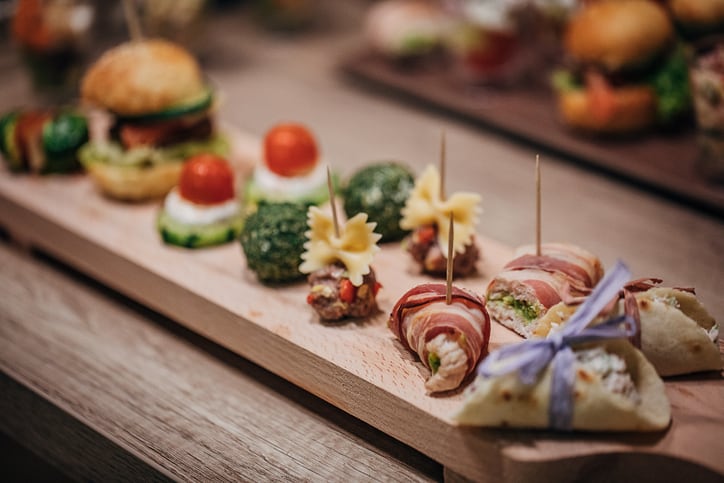In this month’s special edition – Flavors and colors in focus: From emerging consumer demands to new manufacturing strategies – FoodNavigator-USA explores how industry stakeholders are responding to shifting consumer preferences stoked first by the pandemic and then by ongoing inflation and political unrest at home and abroad.
In a video short at the Winter Fancy Food Show, the founder of a startup selling the boiled peanuts – an iconic snack typically enjoyed south of the Mason-Dixon line – explains how consumer demand for authentic flavors and cultural connections through food are helping “regional dishes” expand beyond their long-held geographic boarders.
In addition, a special edition of FoodNavigator-USA’s Soup-To-Nuts podcast showcases how brands across categories that showcased at the Fancy Food Show are helping home cooks more easily replicate global and regional cuisine in their kitchens with convenient applications. It also explores how they are encouraging consumers to try new flavors by pairing them with familiar tastes and formats.
The team also examines how health concerns elevated by state and federal governments are influencing new product development and pressuring brands to reformulate with lower sugar and sodium and replace artificial dyes with natural alternatives.
For example, Sensient Technologies CEO Paul Manning shares how now is the time to reformulate products with natural alternatives to Red Dye No. 3, which FDA recently de-authorized, and select colors and additives banned by California – even though the compliance deadlines are still years away. He outlines time consuming steps, supply chain challenges and other factors that could delay renovation if companies delay action.
Senior Correspondent Ryan Daily also explores how companies can use supply chain management and insight software to track and stay ahead of state and federal legislation banning additives and colors.
Deputy Editor Deniz Ataman reports how companies navigating government initiatives to reduce sodium and sugar can use flavors and colors to enhance taste perception while maintaining clean labels and healthier nutrition profiles.
Check out all the details of these stories and more by clicking through on the headlines below, or if you are a FoodNavigator-USA subscriber by checking your inbox for the special edition on flavors and colors in focus.
To receive future special editions via email as well as daily news, weekly podcasts and more, register for free for FoodNavigator-USA’s newsletters. Find out more by clicking the yellow “register” button at the top of our homepage or by visiting https://www.foodnavigator-usa.com/Info/Why-register/.
Flavors and colors in focus: From emerging consumer demand to new manufacturing strategies
McCormick: ‘Consumers are increasingly open to flavor exploration and we are matching that with the right innovation’ – Two-thirds of consumers cook to explore new flavors and more than half of Gen Z consumers tried new flavors last year, according to consumer research from McCormick & Co.
From hesitation to exploration: Tips to make global & regional flavors more accessible & approachable – Consumer flavor preferences are all over the map, literally, as they seek adventure, authenticity and cultural connection through globally and locally inspired food and beverage – but all too often they lack the confidence, knowledge and ingredients to recreate at home international and regional dishes with diverse flavor profiles
Demand for authentic flavors and cultural connections expands appeal of regional delicacies – Regional flavors and food are expanding beyond their historic boarders as consumers seek authenticity and a cultural connection to what they eat and drink, according to Innova Market Insights, which estimates nearly 60% of global consumers value ‘experience and adventure’ in their diets
Changing tastes: Gen Z demands ‘neostalgic’ & functional flavors – Demand for naturally flavored products, functional benefits and twists on nostalgic — or “neostalgic” — tastes are spurring food and beverage innovation at a time when Gen Z is beginning to make more household buying decisions.
The color code: Why color is just as crucial as taste – Natural colors like beetroot and matcha provide vibrant hues without the controversy of artificial colors, maintaining a cleaner label coveted by consumers
Sweet and salty flavors: It’s all in your head – From honey and vanilla to umami and kokumi, flavor ingredients can enhance taste perception by engaging multiple senses, offering innovative solutions for sugar and salt reduction
Playing offense: How CPG companies can get ahead of food additive bans – CPG companies are deploying supply chain management and insight software, like that from Blue Yonder, to navigate ever-changing food regulations and plan for future scenarios before they happen
The time to reformulate with natural colors is now – Even though the deadlines to comply with color and additive bans recently passed by California and FDA, food and beverage manufacturers should start reformulating now because selecting, sourcing and preparing facilities to use natural dyes takes longer and includes different logistics than sourcing most artificial colors, warns Sensient Technologies CEO Paul Manning.


